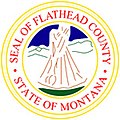Flathead County, Montana | |
|---|---|
 Flathead County Courthouse in Kalispell | |
 Location within the U.S. state of Montana | |
 Montana's location within the U.S. | |
| Coordinates: 48°17′N114°01′W / 48.29°N 114.02°W | |
| Country | |
| State | |
| Founded | 1893 |
| Named after | Flathead Indians |
| Seat | Kalispell |
| Largest city | Kalispell |
| Area | |
• Total | 5,256 sq mi (13,610 km2) |
| • Land | 5,088 sq mi (13,180 km2) |
| • Water | 169 sq mi (440 km2) 3.2% |
| Population (2020) | |
• Total | 104,357 |
• Estimate (2024) | 114,527 |
| • Density | 20.51/sq mi (7.919/km2) |
| Time zone | UTC−7 (Mountain) |
| • Summer (DST) | UTC−6 (MDT) |
| Congressional district | 1st |
| Website | flathead |
| |
Flathead County is a county located in the U.S. state of Montana. At the 2020 census, its population was 104,357, [1] making it the state's fourth most populous county. Its county seat is Kalispell. [2] Its numerical designation (used in the issuance of license plates) is 7. Its northern border is on the state's north border, making it contiguous with the Canada–US border, facing British Columbia.
Contents
- History
- Geography
- Ecology
- National protected areas
- Demographics
- 2020 census
- 2010 census
- Politics
- Infrastructure
- Communities
- Cities
- Census-designated places
- Other unincorporated communities
- Adjacent counties
- Education
- Notable people
- In popular culture
- See also
- References
- External links
Flathead County comprises the Kalispell, Montana Micropolitan Statistical Area, with neighboring Lake County following soon after.


